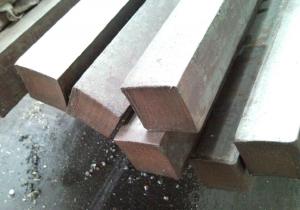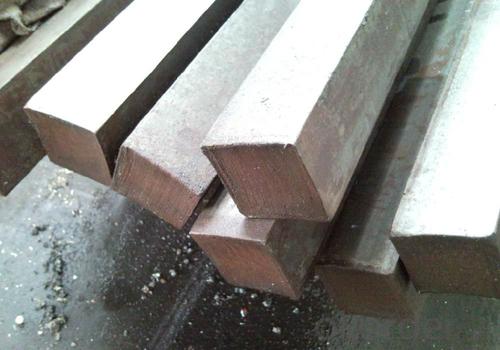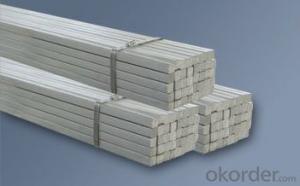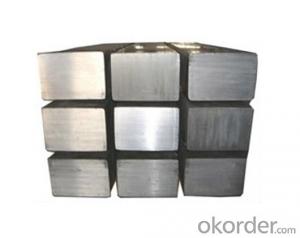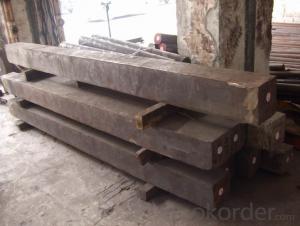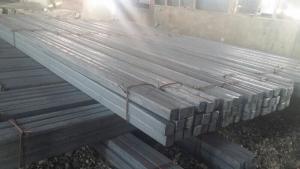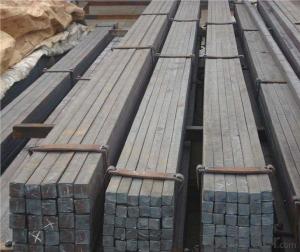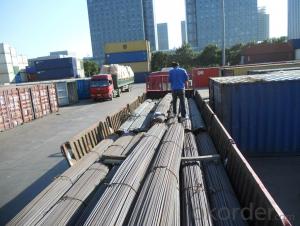0.3% De Chemial Element Cr For Steel Square Bar
- Loading Port:
- China main port
- Payment Terms:
- TT OR LC
- Min Order Qty:
- 25 m.t.
- Supply Capability:
- 10000 m.t./month
OKorder Service Pledge
OKorder Financial Service
You Might Also Like
Product Description
There are two types of Square Bar, one is hot rolled square bar and other one is cold drawn square bar. Our principal products is hot rolled square bar. We dedicate to products with material Q195 and Q235. We offer products with high quality and low price.
Specifications
-Standard: GB,
-Grade: Q195/Q235 or equivalent.
-Chemical Composition:
Standard | Grade | Element (%) | ||||
C | Mn | S | P | Si | ||
GB | Q195 | 0.06~0.12 | 0.25~0.50 | ≤0.050 | ≤0.045 | ≤0.30 |
GB | Q235B | 0.12~0.20 | 0.30~0.70 | ≤0.045 | ≤0.045 | ≤0.30 |
-Mechanical Properties:
Mechanical Properties | Grade | Steel diameter(mm) | |||
≤16 | 16~40 | 40~60 | 60~100 | ||
Yield Point Δs/MPa | Q195 | ≥195 | ≥185 | - | - |
Q235 | 235 | 225 | 215 | 205 | |
Tensile Strength | Q195 | 315~390 | |||
Q235 | 375~500 | ||||
Elongation δ5% | Q195 | ≥33 | ≥32 | - | - |
Q235 | 26 | 25 | 24 | 23 | |
Measures (Big measures):
(Section of Hot-rolled Square Steel Bar)
-Length of a side and Theoretical weight of Square Bar (Big measures).
Length of a side(mm) | Theoretical weight(kg/m) | Length of a side(mm) | Theoretical weight(kg/m) |
53 | 22.05 | 80 | 50.24 |
56 | 24.61 | 85 | 56.72 |
60 | 28.26 | 90 | 63.59 |
63 | 31.16 | 95 | 70.85 |
70 | 38.49 | 100 | 78.50 |
75 | 44.16 |
Notes:
1, The theoretical weights in the list, base on the density of 7.85 g/cm3.
2, Formula for theoretical weight of Square bar: a(length of a side) * a * 0.00785
3, The numbers with *mean that they are not regular or we don’t offer them.
-Regular length of Square Bar:
Steel | Length of a side (mm) | Length of steel (m) |
Normal steel | < 25 | 4~10 |
> 25 | 3~9 | |
Steel of high quality | All measure | 2~6 |
Tool steel >75 | 1~6 |
Usage/Applications
-The Square Steel is normally used as structure steel.
-Row material for other structure steel like steel angles, channels, I-beams, H-beams, etc…
-Row material for steel pipes.
Packaging & Delivery
-Packing Detail:
1, The products can be packed in bundles by steel wires.
2, The weight of each bundle no exceed normally 3 tons.
-Marks: We make tag marks and color marks for each bundle. The tag marks with white background and red company log will be tied up to each bundle. The information is usually including basic information of company and products like product name, specification, etc...and other information required by customers. As for color marks, we will paint both ends of each bundles to make sure that it will be more convenient for customers to distinguish theme from other products.
-Delivery Detail: 30~45 working days after receive buyer’s T.T. or L/C.
Payment:
-Invoicing on theoretical weight or actual weight as customer’s request.
-FOB, CFR or CIF.
-Regular terms of payment:
1, 30% payment in advance, the remaining balance (70% payment) against the copy of B/L.
2, 30% payment in advance, the remaining balance (70% L/C) against the copy of B/L.
3, Negotiable.
-The payment terms will be written in contraction detailed.
- Q: Can a steel square be used for checking the squareness of door frames?
- The squareness of door frames can be checked using a steel square. A steel square, also called a framing square, is a carpentry and woodworking tool frequently employed to verify the accuracy and squareness of different angles and joints. It consists of two arms, usually made of steel, that form a right angle. One arm is longer and known as the blade, while the other arm is shorter and referred to as the tongue. To check if a door frame is square using a steel square, position the longer blade against the inside corner of the frame where the door will be installed. Then, extend the shorter tongue along the inside edge of the door frame. By visually examining the alignment between the door frame and the steel square, you can determine if it is perfectly square or if adjustments are necessary. A door frame that is not square can lead to difficulties during door installation, such as problems with opening and closing, gaps between the door and the frame, or uneven wear on the door over time. By utilizing a steel square, you can ensure that the door frame is properly aligned and square prior to installing the door, resulting in a smooth and functional operation.
- Q: Are there any alternative tools to a steel square for measuring angles?
- Indeed, there exists a variety of alternative tools for measuring angles instead of a steel square. One such alternative is the protractor, a commonly utilized instrument in geometry and construction for angle measurement. Protractors can be crafted from diverse materials such as plastic, metal, or wood, and typically possess a semicircular shape with numerical markings for accurate angle determination. Another option is the bevel gauge or sliding T-bevel, a flat and adjustable tool employed for measuring and transferring angles. Comprising a handle and a lockable blade, this tool facilitates precise angle measurements. Woodworking and carpentry often utilize bevel gauges. Digital angle finders constitute an additional alternative tool. These devices employ digital technology to accurately measure and display angles. Featuring digital screens, they can gauge both degrees and inclinations. Construction, engineering, and metalwork industries commonly rely on digital angle finders. Moreover, specialized angle measuring tools such as angle finders, angle meters, and clinometers cater to specific applications like measuring roof pitch, slope gradients, or vehicle wheel alignments. These tools possess distinct features and mechanisms that enhance angle measurement precision for specific tasks. While a steel square possesses versatility in angle measurement, alternative tools do indeed exist, catering to specific needs and individual preferences.
- Q: Can a steel square be used for checking the squareness of a picture frame corner?
- No, a steel square is not ideal for checking the squareness of a picture frame corner. While a steel square is commonly used for carpentry and other construction purposes, it may not be practical or accurate for checking the squareness of a picture frame corner. Picture frames typically have smaller dimensions, and a steel square may be too large and cumbersome for this task. Additionally, picture frames often have decorative elements or beveled edges that may not align perfectly with a steel square. It is recommended to use a specialized tool such as a framing square or a precision square designed specifically for checking the squareness of picture frame corners. These tools are typically smaller, more precise, and better suited for this specific task.
- Q: What are the different markings on a steel square and what do they mean?
- A steel square, also known as a framing square or carpenter's square, is a versatile tool used in woodworking and construction. It consists of two arms, a shorter one called the tongue, and a longer one called the blade, joined at a right angle. The markings on a steel square serve various purposes and aid in accurate measurements and layout work. 1. Inch and centimeter markings: One of the primary markings on a steel square is the ruler scale along the blade and tongue. These markings are typically in inches on one side and centimeters on the other. They allow for precise measurements when marking or measuring materials. 2. Degree markings: Steel squares often have degree markings along the blade. These markings help in finding angles when making cuts or determining the slope of a roof or stair stringer. The most common degree markings include 45 degrees, 60 degrees, and 90 degrees. 3. Rise and run markings: The rise and run markings are located on the blade of the steel square and are used for calculating the pitch of a roof or the angle of a stair stringer. These markings provide a quick reference for determining the appropriate measurements. 4. Hip and valley markings: For more advanced carpentry work, steel squares may include hip and valley markings. These markings are typically found on the blade and assist in laying out hip and valley rafters, which are common in roof construction. 5. Scribe markings: Scribe markings are small notches or holes located on the tongue of the steel square. These markings allow for accurate marking of parallel lines or transferring measurements from one surface to another. They are particularly useful when marking the depth of a cut or when aligning materials during layout work. Understanding the different markings on a steel square is essential for accurate measurements and layout work. By utilizing these markings effectively, carpenters and woodworkers can ensure precision and efficiency in their projects.
- Q: Can a steel square be used for laying out a patio?
- Yes, a steel square can be used for laying out a patio. A steel square is a versatile tool that can be used to measure right angles and ensure accurate and square corners during the patio layout process. It can help in aligning and positioning the patio pavers or stones, resulting in a well-designed and level patio surface.
- Q: Can a steel square be used for checking the alignment of a scroll saw table?
- Checking the alignment of a scroll saw table can be done with a steel square. A steel square is a versatile tool commonly used in woodworking and metalworking to check the accuracy and alignment of different components. To ensure the table is perfectly perpendicular to the blade, which is vital for precise cuts, a steel square can be used. By placing the steel square against both the table and the blade, it is easy to determine if the alignment is correct. Any deviations can be adjusted to ensure proper alignment, leading to better cutting accuracy and quality.
- Q: Can a steel square be used for creating parallel lines?
- Yes, a steel square can be used for creating parallel lines. A steel square, also known as a framing square or carpenter's square, is a versatile tool used by carpenters, woodworkers, and other tradespeople for various purposes, including marking parallel lines. The long and straight edges of a steel square allow for accurate and precise measurements, making it suitable for creating parallel lines in construction projects, woodworking, and layout work. By aligning one edge of the square with an existing line or edge and using a pencil or marking tool along the other edge, parallel lines can be easily marked or drawn.
- Q: What is the purpose of the lip or flange on a steel square?
- The lip or flange on a steel square serves the purpose of providing a reference edge for marking lines or making precise measurements. Typically positioned perpendicular to the body of the square, it allows for alignment with the workpiece's edge. By sliding the lip along the material's edge, it ensures proper alignment of the square and enables accurate marking or measuring. This useful feature finds particular application in woodworking, metalworking, and other trades that require precision. Moreover, the lip or flange can also function as a stop or guide for repetitive cuts or layouts, further enhancing its usefulness. Overall, the steel square's lip or flange enhances precision and efficiency in various industries by improving the accuracy of different tasks.
- Q: Can a steel square be used for wainscoting installation?
- Wainscoting installation can indeed utilize a steel square. A steel square is a tool that is both versatile and durable, frequently employed in carpentry and woodworking projects. Its primary function is aiding in the measurement and marking of right angles, as well as guaranteeing accurate cuts and joinery. During wainscoting installation, a steel square proves useful for marking and measuring the height and width of the panels, ensuring proper alignment and levelness. Additionally, it can assist in verifying squareness and making precise cuts when trimming panels to accommodate corners or obstacles. In summary, a steel square serves as a valuable asset for achieving meticulous and professional wainscoting installation.
- Q: Can a steel square be used for checking the squareness of a fence?
- Yes, a steel square can be used to check the squareness of a fence. A steel square, also known as a framing square or carpenter's square, is a versatile tool commonly used in carpentry and woodworking to ensure accuracy and squareness. It consists of a 90-degree angle on one side and a 45-degree angle on the other, making it ideal for checking if corners or angles are perfectly square. By placing the steel square against the fence's corners or edges, one can determine if they are at a perfect 90-degree angle. If the steel square fits snugly and aligns perfectly with the fence, then it indicates that the fence is square. If there is any gap or misalignment, it indicates that adjustments need to be made to achieve squareness. Therefore, a steel square is a reliable tool for checking the squareness of a fence.
Send your message to us
0.3% De Chemial Element Cr For Steel Square Bar
- Loading Port:
- China main port
- Payment Terms:
- TT OR LC
- Min Order Qty:
- 25 m.t.
- Supply Capability:
- 10000 m.t./month
OKorder Service Pledge
OKorder Financial Service
Similar products
Hot products
Hot Searches
Related keywords
